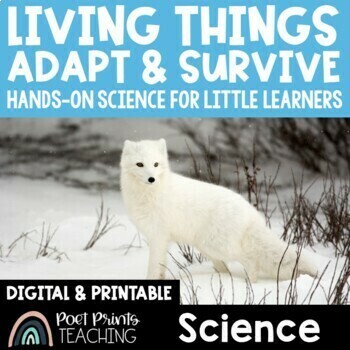Living Things Adapt and Survive | Science Unit
- Zip
- Google Apps™

What educators are saying
Also included in
- Plan all of your Grade 1 Science units at the click of a button with this discounted bundle of 5 engaging science units for little learners! All 5 science units are perfect for grade 1 in British Columbia (they align to the BC Big Ideas!) and NGSS.This bundle covers all of the Grade 1 BC Big IdeasPrice $30.99Original Price $43.50Save $12.51
Description
How do living things survive? How do living things adapt to their environment? This is a fun and engaging LIVING THINGS Science unit for little learners. Students in kindergarten and first grade will have hands-on opportunities to explore how living things adapt and survive in this unit that also includes integrated reading, writing, and project-based learning.
This Living Things Adapt and Survive Science Unit includes:
- Day-by-Day Teaching Instructions - The detailed timeline breaks down how to use all parts of this resource in about 12 school days!
- Mystery Box Introduction Lesson - An introductory lesson designed to build anticipation and help students prepare for a new science unit. This lesson can be done with hands-on gathered materials or printed paper-based items.
- Wonder Wall - Use this bulletin board display as a permanent fixture in your classroom during this unit. This is a great way to introduce students to the concept of inquiry-based learning as they are given the chance to ask questions (inquire) about a topic.
- Vocabulary - Cards to create a Science word wall in your classroom or create vocabulary-based puzzles. Vocabulary for this unit includes: living, nonliving, plant, animal, grow, breathe, reproduce, environment, adapt, hibernate, dormancy, mimicry, camouflage, territorial, prey
- Reading - Two short nonfiction readers titled Living Things and NonLiving Things and Living Things Adapt. Each passage is available in two levels.
- Writing - A short writing lesson where the topic pertains to living things. Students can choose from one of two journal prompts. The writing paper is available in three formats so that you can choose the template that works best for each student.
- Lesson: Living Things and Nonliving Things - Students will determine the difference between living things and nonliving things. Students will show their learning on a simple cut/sort/glue activity
- Lesson: Structural Features of Plants and Animals - Students will learn about the structural features of a simple plant and the physical parts of five animals (koala, eagle, fish, bear, horse). Choose which animals to study, or complete all 6 cut and glue worksheets!
- Lesson: Plants and Animals Around Me - Students will explore local plants and animals! This lesson is a great chance to introduce students to local plants and animals and teach about how they interact with their environments. Students will create a tabbed booklet showcasing either local plants or animals in your area.
- Project: Local Plant or Animal Lapbook - This project-based-learning activity asks students to ‘dive deeper’ into a single local plant or animal. Students will create a simple researched lapbook project on their chosen plant or animal. This can be done as an individual project (everyone chooses a different animal) or as a whole-group topic study (everyone creates a project on the same plant or animal).
Check out the rest of the Science for Little Learners series...
Weather and Seasons - A hands-on unit exploring daily and seasonal changes
Light and Sound - Exploring the science of light and sound in a hands-on (and digital!) unit
All About Matter and Materials
Curriculum Integration:
British Columbia (Grade 1)
- Big Idea: Living things have features and behaviours that help them survive in their environment.
Content:
- Classification of living and nonliving things
- Names of local plants and animals
- Structural features of living things in the environment
- Behavioral adaptations of animals in the local environment
NGSS
•K-LS1-1 – Use observations to describe patterns of what plants and animals (including humans) need to survive.
•K-ESS2-2 – Construct an argument supported by evidence for how plants and animals (including humans) can change the environment to meet their needs
•K-ESS3 – 1 – Use a model to represent the relationship between the needs of different plants or animals (including humans) and the places they live.






